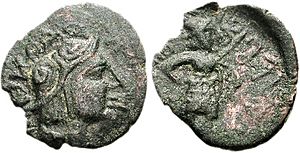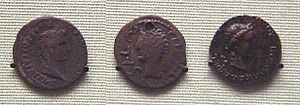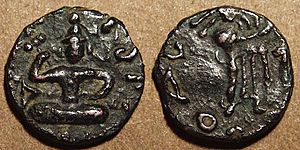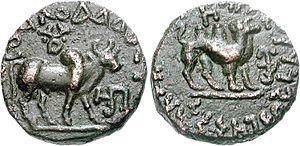Kujula Kadphises facts for kids
Quick facts for kids Kujula Kadphises |
|
|---|---|
| Kushan emperor | |
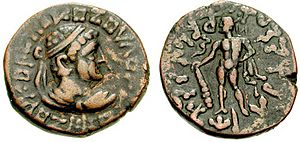
Tetradrachm of Kujula Kadphises (30-80 CE) in the style of Hermaeus.
Obv: Hermaios-style diademed bust. Corrupted Greek legend: ΒΑΣΙΛΕΩΣ ΣΤΗΡΟΣΣΥ ΕΡΜΑΙΟΥ ("Basileos Sterossy Hermaiou"): "King Hermaeus, the Saviour". |
|
| Reign | 30 CE - 80 CE |
| Predecessor | Heraios |
| Successor | Vima Takto |
| Died | 80 CE |
| Dynasty | Kushan |
Kujula Kadphises (Kushan language: Κοζουλου Καδφιζου, also Κοζολα Καδαφες; Kharosthi: 𐨐𐨂𐨗𐨂𐨫 𐨐𐨯, IAST: Ku-ju-la Ka-sa, Kujula Kasa); Ancient Chinese: 丘就卻, Qiujiuque; reigned 30–80 CE, or 40-90 CE according to Bopearachchi) was a Kushan prince who united the Yuezhi confederation during the 1st century CE, and became the first Kushan emperor. According to the Rabatak inscription, he was the great grandfather of the great Kushan king Kanishka I. He is considered the founder of the Kushan Empire.
History
The origins of Kujula Kadphises are quite obscure, and he is usually believed to be a descendant of the Kushan ruler Heraios, or possibly identical with him. However, Kujula shares his name (Kushan: Κοζουλου on some of his "Hermaeus" coins, or Κοζολα on his "Augustus" coins) with some of the last Indo-Scythian rulers, such as Liaka Kusulaka (Greek: Λιακα Κοζουλο), or his son Patika Kusulaka, which might suggest some family connection.
Chinese accounts
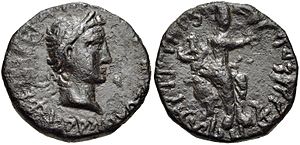
Obv Laureate Julio-Claudian style head right. Greek legend Greek legend around: ΚΟΖΟΛΑ ΚΑΔΑΦΕϹ XOPANOV ZAOOV.
Rev Kujula Kadphises seated right, raising hand; tripartite symbol to left. Legend Khushanasa Yauasa Kuyula Kaphasa Sacha Dhramatidasa.
In the process of their expansion eastward, Kujula Kadphises and his son Vima Takto (or Vema Tahktu) seem to have displaced the Indo-Parthian kingdom, established in northwestern India by the Parthian Gondophares since around 20 CE:
His son, Yangaozhen [probably Vema Tahktu or, possibly, his brother Sadaṣkaṇa], became king in his place. He defeated Tianzhu [North-western India] and installed Generals to supervise and lead it. The Yuezhi then became extremely rich. All the kingdoms call [their king] the Guishuang [Kushan] king, but the Han call them by their original name, Da Yuezhi [Great Yuezhi].
The invasion of the Indo-Parthian kingdom led by Kujula Kadphises is thought to have occurred some time after 45 CE, during the reign of Gondophares's successors: Abdagases and Sases.
Genealogy according to the Rabatak inscription
The connection of Kujula with other Kushan rulers is described in the Rabatak inscription, discovered in Rbatak, Afghanistan some years ago, which was written by Kanishka. Kanishka makes the list of the kings who ruled up to his time: Kujula Kadphises as his great-grandfather, Vima Taktu as his grandfather, Vima Kadphises as his father, and himself Kanishka:
And he [Kanishka] gave orders to make images of the same, (namely) of these gods who are written herein, and he gave orders to make (them) for these kings: for King Kujula Kadphises (his) great grandfather, and for King Vima Taktu (his) grandfather, and for King Vima Kadphises (his) father, and for himself, King Kanishka.
Coinage
The coinage of the Kushan ruler, Kujula Kadphises, shows us the enlargement of the religious horizon of the Kushans. His first issue, which has the debased portrait and name of Hermaeus on the obverse, shows Heracles on the reverse, still following the Greek tradition, even though Heracles may be the interpretatio Graeca of the Iranian god Verethragna. Contrary to earlier assumptions, which regarded Kujula Kadphises as Buddhist on the basis of the epithet of the 'satyadharmasthita' epithet, it is now clear from the wording of a Mathura inscription, in which Huvishka bears the same epithet satyadharmasthita , that the kingdom was conferred upon him by Sarva (Shiva) and Scamdavira (Candavlra), that is, he was a devotee of the Hindu God Siva. It is striking to see that Kujula Kadphises has already adopted the worship of Siva and the use of Kharosthï script at such an early date.
See also
 In Spanish: Kujula Kadphises para niños
In Spanish: Kujula Kadphises para niños


